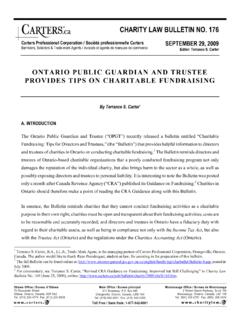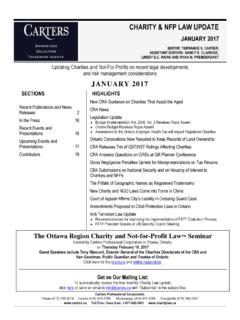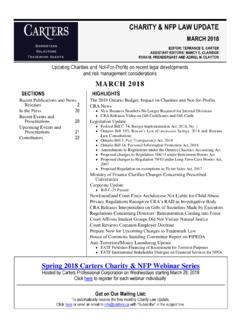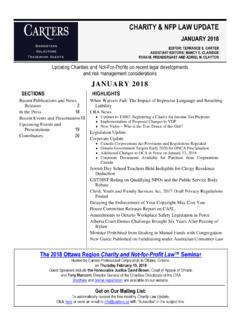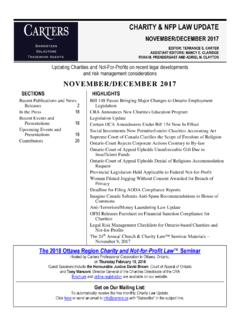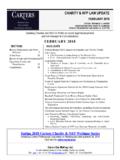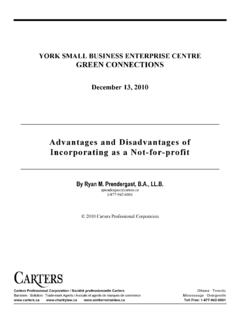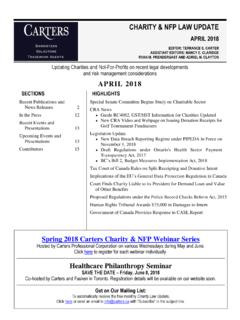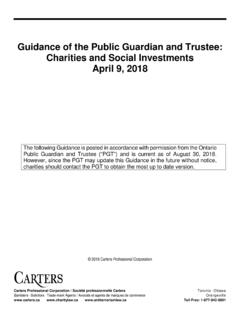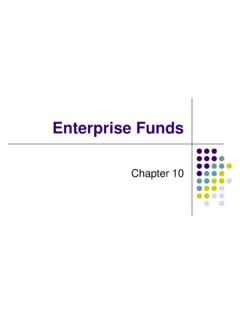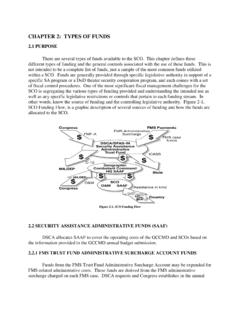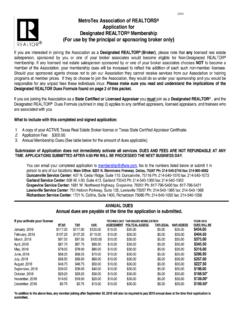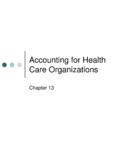Transcription of Donor-Restricted Charitable Gifts: A Practical …
1 CARTERS PROFESSIONAL CORPORATIONBARRISTERS, SOLICITORS & TRADE-MARK AGENTSA ffiliated with Fasken Martineau DuMoulin LLPSoci t professionnelle Carters Avocats et agents de marques de commerceAffili avec Fasken Martineau DuMoulin , / BureauxOrangeville (519) 942-0001 Ottawa (613) 235-4774 Toll Free: 1-877-942-0001By Appointment / Par rendez-vousToronto (416) 675-3766 London (519) 937-2333 Vancouver (877) 942-0001 2006 CAGP*ACPDP ANNUAL NATIONAL CONFERENCE CANADIAN ASSOCIATION OF gift PLANNERS (CAGP) Reprint from The Philanthropist Fall 2003 Donor-Restricted Charitable Gifts: A Practical overview Revisited II (originally published September/December 2003) By Terrance S. Carter, , 2006 Carters Professional Corporation Donor-Restricted Charitable GIFTS: A Practical overview REVISITED II By Terrance S. Carter, , TABLE OF CONTENTS A. INTRODUCTION .. 1 B. SETTING THE 2 C. PRELIMINARY LEGAL CONSIDERATIONS .. 3 1. The Legal Nature of a 3 2.
2 What Is the Basic Nature of a Charitable Purpose? .. 4 3. What Is the Definition of a Charitable Purpose? .. 4 4. What Are the Basic Attributes of a Charitable Purpose Trust?.. 5 5. Does a Charitable Purpose Trust Have Application To a Charitable Corporation? .. 6 D. WHAT IS THE DIFFERENCE BETWEEN UNRESTRICTED AND Donor-Restricted Charitable GIFTS? .. 9 1. Unrestricted Charitable Gifts .. 9 a) What Is the Nature of an Unrestricted Charitable gift ?.. 9 b) What Are Some Examples of Unrestricted Charitable Gifts?.. 10 2. Donor-Restricted Charitable Gifts .. 10 a) What Is the Nature of a Donor-Restricted Charitable gift ?.. 10 b) Different Forms of Legal Restrictions .. 11 E. WHAT ARE THE GENERAL FORMS OF Donor-Restricted Charitable GIFTS?.. 11 1. Special Purpose Charitable Trusts .. 11 a) What Is the Nature of a Special Purpose Charitable Trust?.. 11 b) Are Special Purpose Charitable Trusts Recognized In Canadian Law? .. 12 c) The Requirements For the Creation of a Special Purpose Charitable 20 d) Endowment Funds.
3 25 e) Donor restricted -Use 27 f) restricted Charitable Trust Property .. 28 g) Implied Special Purpose Charitable Trust 32 2. Donor-Advised Funds and Precatory Trusts .. 36 a) What Is the Nature of Donor-Advised Funds and Precatory Trusts?.. 36 b) What Is a Precatory Trust (Designated gift )?.. 37 c) What Are Donor-Advised Funds? .. 38 3. Conditional Gifts .. 39 a) What Is the Nature of a Conditional gift ? .. 39 b) What Is a Condition Precedent? .. 40 c) What Is a Condition Subsequent?.. 41 4. Determinable 42 5. Gifts Subject to Donor Directions Under the Charities Accounting 42 6. Ten-Year Gifts Under the Income Tax Page ii F. WHAT HAPPENS WHEN THERE IS A FAILURE OF A DONOR RESTRICTION?.. 45 1. General Comments .. 45 2. Failure of a Conditional 45 3. General Liberal Court 46 4. Failure of a Special Purpose Charitable 47 a) Nature of Failure and Court 47 b) Can a Donor-Restricted Charitable gift be Unilaterally Varied? .. 47 c) Cy-pr s Scheme-Making Power.
4 48 d) Administrative Scheme Making Power .. 51 G. WHAT ARE THE DUTIES ASSOCIATED WITH Donor-Restricted Charitable GIFTS? .. 52 1. Nature of the 52 2. Duty to Comply With Donor Restrictions .. 52 3. Duty to Invest .. 54 4. Duty to Protect and Conserve Trust Property .. 55 5. Duty to Apply For a Scheme .. 55 6. Duty to Keep 55 H. WHAT ARE THE LEGAL CONSEQUENCES OF FAILING TO COMPLY WITH DONOR RESTRICTIONS?.. 56 1. Consequences Under Common 56 a) Personal Liability for Breach of Trust .. 56 b) Liability for Ultra Vires or Unauthorized Charitable Purposes .. 56 c) Liability for Accrued Interest .. 57 d) Liability for Third Party Claims by Donors and Residual Beneficiaries .. 57 2. Consequences Under Statute Law .. 57 a) The Charities Accounting 57 b) Income Tax 58 3. Consequences Under Criminal Law .. 58 4. What Should Be Done If a Failure To Comply With Donor Restrictions Is Found? .. 59 I. SELECTED TAX CONSIDERATIONS INVOLVING Donor-Restricted Charitable GIFTS .. 60 1.
5 10-Year Gifts .. 60 a) Defining and Documenting 10-Year 60 b) Expenditure of Income .. 62 c) Consequences of Expending Capital Prior To the Expiry of 10 Years .. 64 d) Expenditure of 10-Year Gifts After Expiry of 10 65 e) Transfer of 10-Year Gifts .. 66 f) Managing 10-Year Gifts .. 67 2. Conditional Gifts .. 68 3. When Will Excessive Donor Control Defeat a gift ? .. 69 4. Donor Restrictions That Benefit the Donor .. 73 J. WHO CAN ENFORCE DONOR RESTRICTIONS? .. 75 1. The Importance of Enforcing Donor 75 2. What Involvement Does the Government Have in Enforcing Donor Restrictions?.. 75 3. Can Donors and/or Interested Individuals Enforce Donor Restrictions? .. 76 Page iii K. EXIGIBILITY OF SPECIAL PURPOSE Charitable TRUSTS .. 78 1. Importance of the 78 2. Commentary on the Christian Brothers Ont. Decision .. 80 3. Impact of the Christian Brothers Ont. Decision .. 81 4. Developing a Strategy in Response .. 83 L. HOW SHOULD Donor-Restricted GIFTS BE MANAGED ONCE RECEIVED?
6 83 1. Identifying the Nature of the Charitable gift .. 84 2. Reviewing and Approving Donor Restrictions .. 84 3. Effective Ongoing Management of Donor-Restricted Charitable Gifts .. 85 M. HOW CAN Donor-Restricted Charitable GIFTS BE AVOIDED IN THE FIRST INSTANCE? .. 86 N. PREVENTIVE STEPS TO REDUCE LIABILITY INVOLVING Donor-Restricted Charitable GIFTS .. 87 O. CONCLUSION .. 88 2006 CAGP*ACPDP ANNUAL NATIONAL CONFERENCE CANADIAN ASSOCIATION OF gift PLANNERS (CAGP) Reprint from The Philanthropist Fall 2003 Donor-Restricted Charitable GIFTS: A Practical overview REVISITED II By Terrance S. Carter, , * A. INTRODUCTION Since the presentation on which this article is based, there has been considerable public recognition of the importance of Donor-Restricted Charitable gifts. This increased recognition has occurred because of a realization that with the new generation of philanthropists, a different approach to Charitable giving which recognizes the importance of accommodating the donor s wishes as well as the expectations of the charity, is emerging.
7 As stated by a senior fundraiser: Philanthropy has become donor rather than cause centred. Altruism has become self-interested, and we now have the donor-consumer .. What will move donors is their wants, not our [emphasis added] This donor centred approach to philanthropy is in part a reflection of the Baby Boomer generation s need to dominate and control all aspects of their lives. As the Boomers reach their forties and fifties, they are no longer prepared to part with their wealth by leaving it in the sole control of the charity. Instead, they are insisting on exercising some measure of control over their gifts. In a Time Magazine article on The New Philanthropy, the following observation was made: * Carters Professional Corporation is affiliated with Fasken, Martineau, DuMoulin LLP, Barristers and Solicitors. Terrance Carter serves as counsel to Fasken, Martineau, DuMoulin LLP on Charitable matters. This article was originally published in the September 2003 and December 2003 issues of The Philanthropist, and was developed and updated by the author (as of January 2004), from a presentation to the 3rd Annual Estates and Trusts Forum of the Law Society of Upper Canada in November 2000.
8 The author would like to thank Johanna Blom, then an Articling Student, for research and editing assistance in preparing this revised article. The author would also like to acknowledge the assistance of Professor James Phillips of the University of Toronto in reviewing and commenting upon an earlier version of this article, as well as the original research and editing assistance of Adam Parachin of Fasken, Martineau, DuMoulin, on the earlier version. 1 Mark Sarner, The Capital Campaign: Capital Fundraising at the Millennium , Canadian Fundraiser (August 16, 2000) at 6. Page 2 of 88 Silicone Valley Chief Executive Officers, along with other newly rich Americans, are finally stepping up to the collection plate. And just as they transformed American business, members of the new generation are changing the way philanthropy is done. Most are very hands [emphasis added] As a result of the greater demand by donors to exercise control over their gifts, there is an increasing obligation placed upon charities and their legal counsel to ensure that restrictions imposed by donors are respected, while at the same time ensuring that the charity is able to comply with those restrictions, and making sure that they do not unnecessarily expose the charity and its board of directors to legal liability.
9 Thus, the following article provides greater focus on situations in which charities and their boards of directors may be exposed to liability, and what Practical steps can be taken to avoid such risks. B. SETTING THE STAGE The following scenario provides an illustration of a typical situation which is not uncommonly faced by lawyers who advise charities. As legal counsel for a financially troubled charity which operates a youth centre for street kids, you are asked to advise on the legal implications of the charity ceasing to operate. The board is contemplating a possible amalgamation with another charity or, alternatively, dissolving the charity and transferring its remaining assets to another charity that has similar Charitable objectives. In reviewing a copy of the current financial statement for the charity, you notice that there is a reference in the statement to the Simpson Endowment Fund . As part of your due diligence in advising the charity, you ask for details.
10 You are advised that the Fund was established years ago when Mr. Simpson died. He left $50,000 to the charity to be used to build a gym as an addition to the youth centre. Unfortunately, the gym addition was never built because the $50,000 gift from the Simpson estate was insufficient to ensure the completion of the project and monies could not be raised from other supporters. When you asked why the current balance in the Simpson Endowment Fund is now only $20,000 instead of the original $50,000 plus accrued interest, you are advised that, on occasion over the last years, the board has had to use some of the fund to balance the operating budget of the youth centre. 2 Karl Taro Greenfield, A New Way of Giving , Time Magazine, July 24, 2000 at 39. Page 3 of 88 At a board meeting, one of the new members who was not aware of the history of the Fund asks you whether or not the Fund has been properly dealt with and, if not, what the legal implications are for the charity and its board of directors and what should be done to rectify any irregularities if they have occurred.
